Has America always wanted 'your poor, your tired, your huddled masses'?
Immigration is as old as human history. People move from one place to another for many reasons. When migration occurs across a national border, it is called immigration. When relocation happens within the same country, it is termed emigration. Historians often attribute the movement to "push-pull" factors. Sometimes conditions at home become so dangerous or challenging that people are forced to move elsewhere. Wars, famines, economic issues or political oppression are often "push" factors encouraging people to seek safety or better conditions somewhere else. Sometimes opportunities in a new land attract newcomers. Cheap and fertile farmlands in the United States lured hundreds of thousands of immigrants in the latter 19th century. Political and religious freedom, good jobs and educational opportunities "pulled" many to America to seek a fresh start in the states.
Immigration to Iowa
Historians usually identify three waves of immigration to Iowa, characterized by the national origin of the immigrants. The fertile Iowa prairies offered for sale at $1.25 an acre attracted thousands from northern Europe and the British Isles. The state government and railroad companies wrote glowing accounts of Iowa’s promise and distributed brochures across Europe in native languages to encourage migration. Germans and Irish were the top two contingents respectively, but British, Dutch, Norwegian and Czech families also swelled Iowa’s population. While new arrivals often formed tightly-knit ethnic communities, they also mingled with native-born settlers from the Ohio River Valley and the Upper South. They arrived with their state churches — Catholic, Lutheran, Reformed, Anglican — and established newspapers in their native language. During World War I, patriotism in support of the United States often attacked those who had maintained strong cultural ties to their European homeland, especially the Germans. By the time the fighting ceased, Iowa had become more homogenized with less emphasis on cultural diversity.
A second wave of immigration began toward the end of the 19th century and continued through the 1920s. Southern and Eastern Europeans brought new faces to the eastern and Midwestern cities, but also to smaller towns. Italians, Croatians, Greeks and Russians took jobs in coal mines and meat packing plants. Mexicans began heading north to fill jobs during World War I. Unlike native-born American groups and immigrants from Northern Europe who were predominately Protestant, the second-wave immigrant groups brought Catholic affiliations and unfamiliar languages. Sometimes they came as families, but frequently a single male would come over first, get a job and sponsor a brother or nephew. The two would work together to buy tickets for other family members until extended families were reunited in America. At the national level, native-born Americans feared the growing numbers of these new arrivals. Congress passed laws restricting immigration from southern and eastern Europe (and Asia) in favor of northern Europeans.
Civil wars, political oppression and poverty sent a third wave of immigrants to Iowa. In the 1970s, Iowa’s Governor Robert Ray became the only governor in the nation to initiate a government-sponsored resettlement program for southeast Asians who were the victims of the Vietnam War. Refugees from Somalia, Bosnia and other nations in upheaval found their way to Iowa. Churches became active in sponsoring immigrants and helping them to adapt to their new Iowa homeland. Mexicans and other immigrants from Latin American nations found work in agriculture and meat packing. Mechanization in Iowa meat-packing plants created demand that immigrants were willing to take, and towns with these plants — Perry, Storm Lake, Marshalltown — soon attracted a sizable migrant population. Schools faced challenges teaching classes to many students whose native language was not English.
African Americans and Iowa
African Americans in Iowa present a unique history. While some African-American Iowans in the past 50 years came directly from African nations, most are from families that moved north at some point from the American South. The first African Americans in the state often lived in Mississippi River towns with the direct water connection to the South. Others came to the state recruited by meat-packing plants or coal companies. When African-American workers were hired to replace striking white workers, communities dealt with racial tensions. Even when Iowa laws made discrimination in housing, transportation, education or employment illegal, African Americans often faced hurdles to full integration.
Who can come to America is a divisive political issue. Some want to keep the doors open for those seeking a better life, while others worry that immigrants may take jobs from native-born Americans or change the nature of American society. Regardless, Iowa has attracted newcomers since its earliest days and now boasts citizens from around the world.
Supporting Questions
How have laws regulating immigration changed over time?
- Burlingame Treaty, 1868 (Document)
- Chinese Exclusion Act, May 6, 1882 (Document)
- "How John May Dodge the Exclusion Act" Illustration, July 12, 1905 (Political Cartoon)
- "Immigration Report: A Banner Year" Newspaper Article, December 16, 1907 (Document)
- Babel Proclamation, May 1918 (Document)
- Iowa Governor Robert Ray Congressional Hearing Testimony about Refugee Legislation, May 24, 1979 (Document)
- Iowa English Language Reaffirmation Act, 2002 (Document)
- Truth in Immigration (TRIM) Act, November 14, 2005 (Document)
How have responses and supports for immigrants and refugees evolved over time?
- "Move On" Silent Film of New York's Lower East Side, October 27, 1903 (Video)
- "The Americanese Wall," March 25, 1916 (Political Cartoon)
- Sewing Class for Refugee Students in Mt. Ayr, Iowa, 1918 (Image)
- Revocation of Babel Proclamation, December 4, 1918 (Document)
- "Demand Return Fare for Mexican Labor" Newspaper Article, July 31,1920 (Document)
- Iowa Tai Dam Newsletter, December 19, 1975 (Document)
How have attitudes or viewpoints about immigration changed over time?
- "Examiner's Questions for Admittance to the American (or Know-Nothing) Party," July 1854 (Document)
- "Thoughts for Americans" Lyric Sheet, 1856 (Document)
- U.S. Rep. John Kasson (R-IA) Speech on Chinese Immigration, March 22, 1882 (Document)
- "Restrictions of Immigration" Iowa Newspaper Article, May 9, 1900 (Document)
- "Most Iowans Oppose More Boat People" Des Moines Register Article, September 30, 1979 (Document)
- H.Res 683, A Resolution from the U.S. Congress Regarding Chinese Exclusion Act, June 8, 2012 (Document)
| Immigration: Regulation, Response and Attitudes in America Source Set Teaching Guide |
| Printable Image and Document Guide |
Burlingame Treaty, 1868
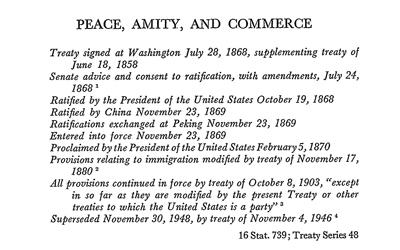
Description
The Burlingame Treaty was signed in July 1868, and it outlines a friendly relationship between China and the United States. The Burlingame Treaty gave both China and the United States rights to move freely in each others respective countries.
Chinese Exclusion Act, May 6, 1882

Description
The Chinese Exclusion Act was approved on May 6, 1882. It was the first significant law restricting immigration into the United States. The Act also was a reversal in relations with China as outlined in the Burlingame Treaty…
"How John May Dodge the Exclusion Act," July 12, 1905
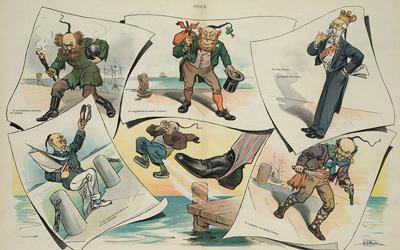
Description
This illustration shows Uncle Sam's boot kicking a Chinese immigrant off a dock as part of an anti-Chinese immigration campaign. Vignettes show how the Chinese can possibly emigrate to the United States, by coming as "a cup-challenger" in yacht races, "as an industrious…
"Immigration Report: A Banner Year" Newspaper Article, December 16, 1907
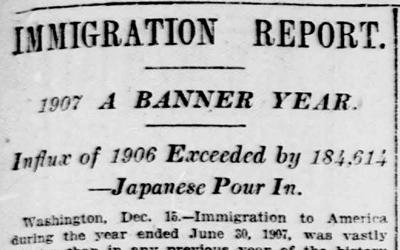
Description
This article appeared in the New York Tribune and discussed what a "banner" year it has been for immigration. The article gives statistics on the number of immigrants from various countries, as well as impact and effect of laws at the time. …
Babel Proclamation, May 1918

Description
The Babel Proclamation was issued by Iowa's Governor William L. Harding. He took the anti-German sentiment in the wake of World War I further than any other state. The proclamation said, "Only English was legal in public or private schools, in public conversations, on…
Iowa Governor Robert Ray's Congressional Hearing Testimony about Refugee Legislation, May 24, 1979
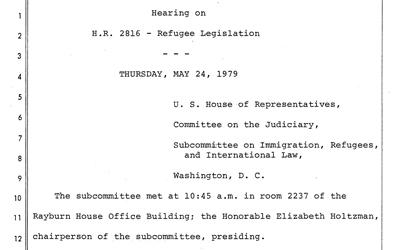
Description
The source is a transcription of Iowa Governor Robert Ray's speech in front of the U.S. House of Representatives' subcommittee on Immigration, Refugees and International Law in 1979. Gov. Ray spoke on his feelings of moral obligation for resettling Tai-Dam refugees in…
Iowa English Language Reaffirmation Act, 2002
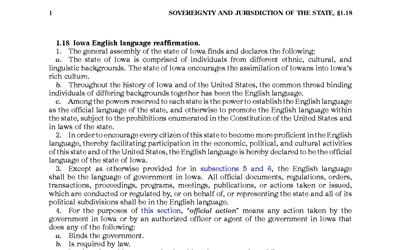
Description
Former Governor Tom Vilsack signed into law the Iowa English Language Reaffirmation Act in 2002. The law reaffirms English as the official language of the state and that all official documents should be in English.
Truth in Immigration (TRIM) Act, November 14, 2005

Description
This piece of legislation, known as the Truth in Immigration (TRIM) Act, directs the Secretary of Homeland Security to annually report to Congress on the number of undocumented immigrants, listed by country of last known habitual residence, who are estimated to be…
"Move On" Silent Film of New York's Lower East Side, October 27, 1903

Description
Filmed in New York's Lower East Side, the scene is a street where several Jewish and Italian push-cart vendors have gathered to sell their goods. In the foreground are fruit and vegetable carts. An elevated railroad track crosses over the street in the background. As…
"The Americanese Wall," March 25, 1916
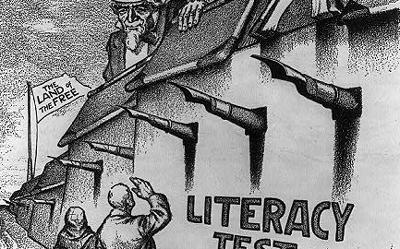
Description
This political cartoon shows Uncle Sam behind a high wall marked "Literacy Test," which is spiked with pen points. The message on the political cartoon reads: "You're welcome, if you can climb it."
Sewing Class for Refugee Students in Mt. Ayr, Iowa, 1918
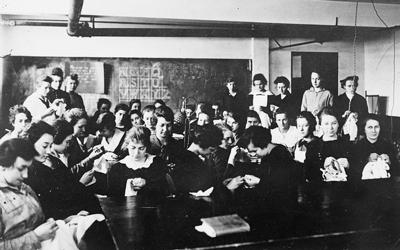
Description
This photograph was taken in Mt. Ayr, located in southeast Iowa. The image shows refugees from Europe taking part in a sewing class.
Revocation of Babel Proclamation, December 4, 1918

Description
The Babel Proclamation was issued by Iowa's Governor William L. Harding. He took the anti-German sentiment in the wake of World War I further than any other state, and he proclaimed that "Only English was legal in public or…
"Demand Return Fare for Mexican Labor" Newspaper Article, July 31,1920
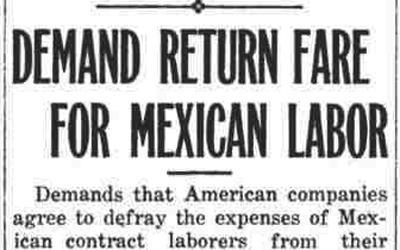
Description
The newspaper article ran in an edition of the Mohave County Miner and Our Mineral Wealth in Arizona. The article details the struggle of temporary migrant laborers in 1920. At issue is return fare to Mexico when work has been completed or if workers…
Iowa Tai Dam Newsletter, December 19, 1975
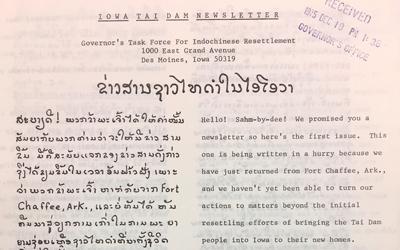
Description
This is an edition of the newsletter created by the governor’s task force on Indochinese resettlement in 1975. The newsletter is in two languages and covers issues related to education and other social service agencies.
"Examiner's Questions for Admittance to the American (or Know-Nothing) Party," July 1854
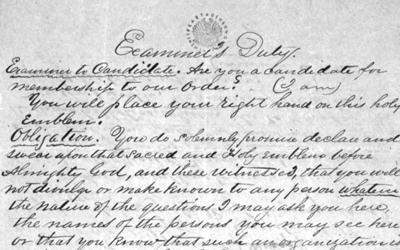
Description
The "obligation" assumed by prospective candidates of the Know-Nothing Party for membership is spelled out in this handwritten document from Newburg, Pennsylvania in July 1854. It required candidates to "solemnly ... swear upon that sacred and Holy emblem before Almighty…
"Thoughts for Americans" Lyric Sheet, 1856

Description
These "Thoughts for Americans" song lyrics are criticizing the Know-Nothing Party’s stance on immigration.
U.S. Rep. John Kasson (R-IA) Speech on Chinese Immigration, March 22, 1882
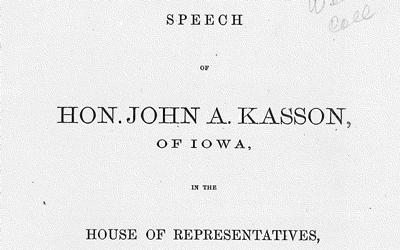
Description
This speech on Chinese immigration was presented before Congress by Iowa U.S. Representative John A. Kasson on March 22, 1882. Kasson argues in his speech against the Chinese Exclusion Act.
"Restrictions of Immigration" Iowa Newspaper Article, May 9, 1900

Description
This newspaper article appeared in the May 9, 1900, edition of the Evening Times-Republican, a Marshalltown newspaper. The article outlines opposition to immigration by trade unions by making the argument immigrants are taking…
"Most Iowans Oppose More Boat People" Des Moines Register Article, September 30, 1979
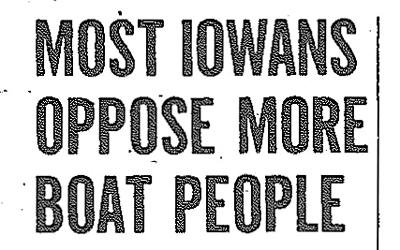
Description
The newspaper article presents and analyzes data from a survey given to Iowans related to their feelings about current refugees from southeast Asia and accepting more refugees. In the article, then-Governor Robert Ray responds to the results that appear to be a…
H.Res 683, A Resolution from the U.S. Congress Regarding Chinese Exclusion Act, June 8, 2012
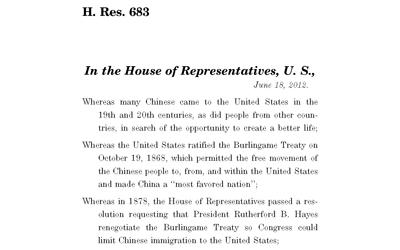
Description
This U.S. House resolution was passed in 2012, and stated that Congress regrets the passage of legislation that adversely affected people of Chinese origin in the United States because of their ethnicity.
Additional Resources
- Iowa Pathways - My Path
This Iowa Public Television webpage features an in-depth look at immigrants and refugees who settled in Iowa dating back to World War II. - "Chinese Immigration in the United States" LOC Resource
This Library of Congress webpage is a section of the "Rise of Industrial America" website. The resource has a number of excerpts from books and texts related to Chinese immigration from a variety of perspectives. - "Immigration" LOC Resource
This Library of Congress website houses a number of primary sources from immigrants from a variety of perspectives. - Chinese Exclusion Act
This "American Experience" episode that aired May 29, 2018, focuses on the origin, history and impact of the 1882 Chinese Exclusion Act.
Iowa Core Social Studies Standards (9-12th Grade)
Listed below are the Iowa Core Social Studies content anchor standards that are best reflected in this source set. The content standards applied to this set are high school-age level and encompass the key disciplines that make up social studies for 9th through 12th grade students.
| No. | Standard Description |
| SS-US.9-12.13. | Analyze how diverse ideologies impacted political and social institutions during eras such as Reconstruction, the Progressive Era, and the Civil Rights movement. |
| SS-US.9-12.17. | Explain the patterns of and responses to immigration on the development of American culture and law. |
| SS-US.9-12.23. | Analyze the relationship between historical sources and the secondary interpretations made from them. |
| SS-US.9-12.25. | Analyze how regional, racial, ethnic and gender perspectives influenced American history and culture. |
| SS-US.9-12.27. | Evaluate Iowans or groups of Iowans who have influenced U.S. History. |
| SS-Gov.9-12.13. | Evaluate the powers and responsibilities of local, state, tribal, national, and international civic and political institutions, how they interact and the role of government in maintaining order. (21st century skills) |
| SS-Gov.9-12.20. | Explain the significance of civic values to a well-functioning democracy including concepts such as conviction vs. compromise, majority rule vs. minority rights, state interests vs. individual interests, rights vs. responsibilities, and other related topics. (21st century skills) |
| SS-Gov.9-12.25. | Evaluate the intended and unintended consequences of the implementation of public policy, specifically looking at the bureaucracy, citizen feedback, public opinion polls, interest groups, media coverage, and other related topics. (21st century skills) |